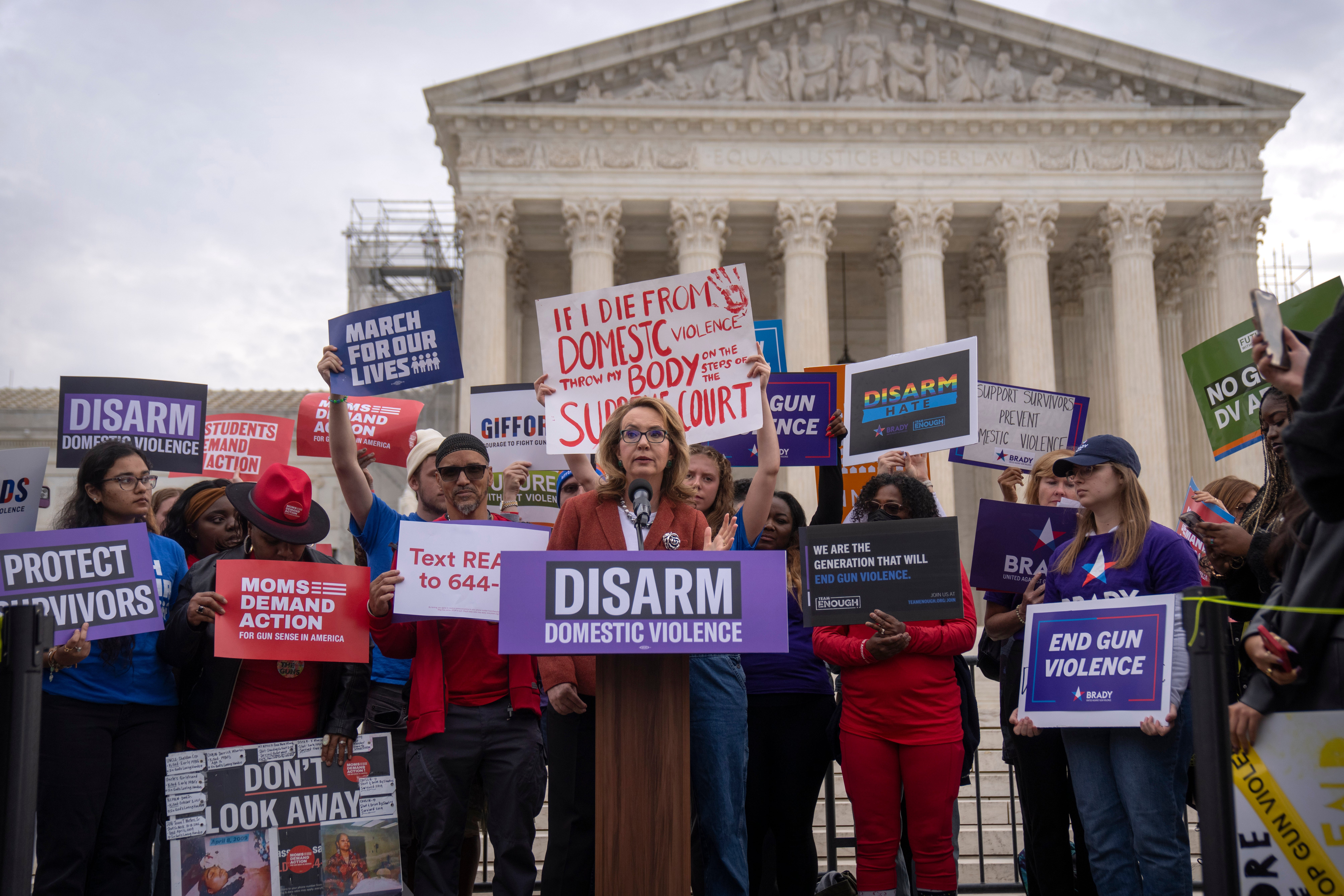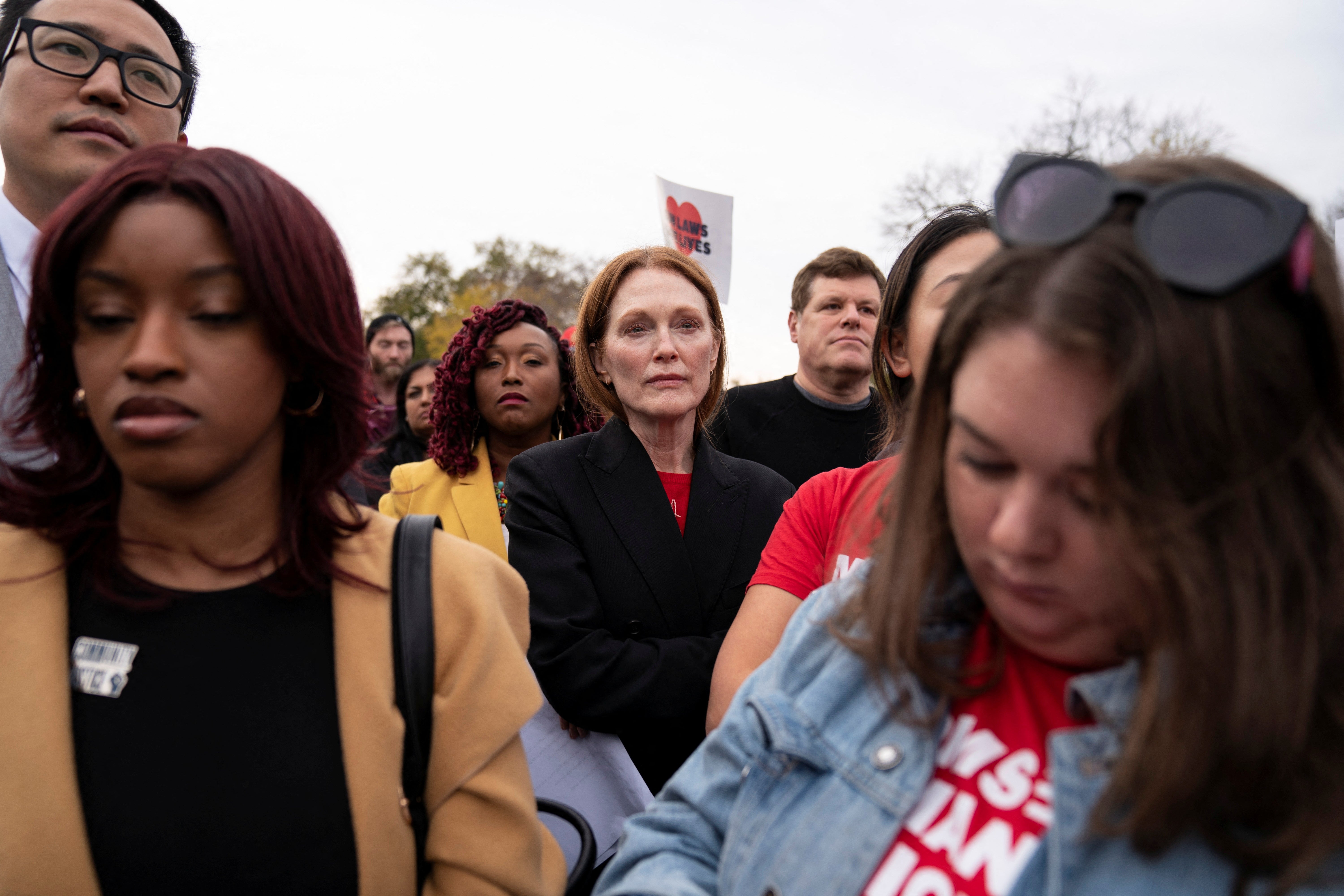Supreme Court seems poised to keep guns away from domestic abusers
Justices will decide if courts went too far overturning federal law intended to protect survivors
Your support helps us to tell the story
From reproductive rights to climate change to Big Tech, The Independent is on the ground when the story is developing. Whether it's investigating the financials of Elon Musk's pro-Trump PAC or producing our latest documentary, 'The A Word', which shines a light on the American women fighting for reproductive rights, we know how important it is to parse out the facts from the messaging.
At such a critical moment in US history, we need reporters on the ground. Your donation allows us to keep sending journalists to speak to both sides of the story.
The Independent is trusted by Americans across the entire political spectrum. And unlike many other quality news outlets, we choose not to lock Americans out of our reporting and analysis with paywalls. We believe quality journalism should be available to everyone, paid for by those who can afford it.
Your support makes all the difference.The Supreme Court appears likely to uphold a law that would keep firearms out of the hands of domestic violence offenders, after the justices heard two hours of arguments in another major Second Amendment case.
A decision in the case of United States v Rahimi — which is expected in late June — could have profound impacts on the ways courts and law enforcement protect abuse survivors, as states wrangle with patchwork laws restricting gun ownership in the face of the nation’s gun violence epidemic.
In oral arguments on 7 November, the justices seemed to lean into the government’s argument of an established precedent of firearm restrictions around identified dangerous individuals. By contrast, they appeared lost in Zackey Rahimi’s lawyer’s muddled argument.
The justices initially focused on the definitions of “responsible” and “law-abiding” in the government’s arguments.
US Solicitor General Elizabeth Prelogar said that she was employing those terms because this was the language used and the “standard this court has articulated” in previous gun-related cases.
Justice Ketanji Brown Jackson also wondered why the government was harkening back to the founding era, when laws around domestic violence and other now well-known gun dangers, like permitting firearms in schools, had yet not been established.
“Throughout our nation’s history, legislatures have disarmed those who have committed serious criminal conduct or whose access to guns poses a danger,” Ms Prelogar said. “For example, loyalists, rebels, minors, individuals with mental illness, felons and drug addicts.”
Michael Wright, Rahimi’s lawyer, seemed to confuse the justices with his argument.
Zackey Rahimi pleaded guilty to violating a law that required him to relinquish his firearm because he had been subject to a two-year restraining order. Rather than giving up his gun, he was involved in five shootings in a two-month span.
Rahimi argued that federal law violates his constitutional right to own a firearm, a decision affirmed by the right-wing-dominated Fifth Circuit federal appeals court just 15 days after the Supreme Court handed down a major decision in a landmark Second Amendment case.
That 2022 ruling in New York State Rifle & Pistol Association v Bruen has changed – if not confused – the way that courts across the country analysed gun laws.
“You don’t have any doubt that your client is a dangerous person, do you?” Chief Justice Roberts asked Mr Wright.
At one point, Mr Wright said he would like to “know what ‘dangerous person’ means.”
Chief Justice Roberts then retorted, “Someone who is shooting at people. That’s a good start.”

Mr Wright also said that there was no historic tradition that resulted in a firearm ban for those who are not convicted felons. He added that while society understood dangerous people, it “rejected the disarmament principle” that this law includes.
However, his argument became less clear when Justice Amy Coney Barrett mentioned Rahimi’s specific restraining order on its own – regardless of the law in question – which stated that he had to give up his gun. She suggested that this firearm relinquishment requirement was built in.
After a court proceeding, “if the finding was that nothing short of surrender of firearms, that would be constitutional,” he replied.
Perhaps in a well-articulated culmination of the justices’ confusion, Justice Elena Kagan called Mr Wright’s argument “untenable,” adding that she thought he was “running away from the argument.”
She continued, “It just seems to be that your argument applies to a wide variety of disarming actions, bans, that we take for granted now, because it’s so obvious that people who have guns pose a great danger to others and you don’t give guns to people who have a history of domestic violence … or the mentally ill, or what have you.”
Rahimi marks the first major gun case to come before the conservative court this year, and potentially gives the court an opportunity to clarify Bruen.
Ms Prelogar said the case is based on a “profound” misreading of Bruen, she said, adding that once the Court “corrects the misinterpretation of Bruen, you can disarm dangerous individuals.”
”It’s an easy case” for three reasons, she said. First, protective orders – and the subsequent firearm relinquishment mandate – “requires individualised findings of dangerousness.”
Second, there is “legislative consensus,” as 48 states and territories share the view that disarmament is an appropriate response to protecting domestic violence victims, the solicitor general continued.
And third, those protections combat “a profound harm,” she added, outlining in a body of evidence and harrowing statistics that illustrate the lethal intersection of domestic violence and gun ownership.
Women are five times more likely to be murdered if her partner has access to a gun, though domestic violence calls are also the most dangerous scenes for law enforcement officers, she said.

The Supreme Court’s decision in Bruen expanded Americans’ right to bear arms by arguing that modern gun laws must have a direct analogy in “history and tradition” – creating an enormous new constitutional hurdle. As Justice Clarence Thomas wrote, “the government must demonstrate that the regulation is consistent with the Nation’s historical tradition.”The decision opened a wave of challenges to restrictions on firearms backed by gun activists.
Lower courts “have been wrong to view Bruen as a blank check to strike down laws,” Janet Carter, senior director of issues and appeals with Everytown Law, said in a call with reporters on Tuesday.
Esther Sanchez-Gomez, litigation director with Giffords Law center, said Ms Prelogar’s request for the court to clarify Bruen could be “hugely important” for navigating the nation’s gun laws.
“Even Chief Justice Roberts, through a joke, noted that shooting someone is sufficient for disarming someone,” she said. “We’re all starting from a baseline premise … Mr Rahimi is the kind of person we don’t want to see with a gun.”
Angela Ferrell-Zabala, executive director of Moms Demand Action, said in a statement that it is “crystal clear that “arming domestic abusers under restraining orders would be an outrageous, devastating and lethal mistake.”
“If the Supreme Court rules to arm abusers, it would mean that the nation’s highest court has put women and families across the country in danger, forcing survivors to live in fear that their abusers can get access to deadly weapons,” she added. “The Supreme Court cannot allow domestic abusers a blank check to buy and possess guns. It must overturn the Fifth Circuit’s decision.”

Join our commenting forum
Join thought-provoking conversations, follow other Independent readers and see their replies
Comments